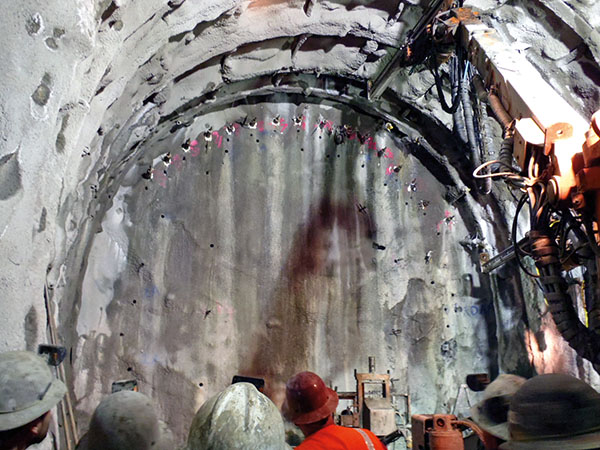



Lake Mead Intake Tunnel No. 3 stabilized using DSI Rock Support Products
Hoover Dam in Lake Mead supplies 90 % of the water for las Vegas. However, during the last 9 years, the United States’ southwest and especially the Las Vegas area in the state of Nevada have experienced a significant drought. As a result, Lake Mead’s surface level has decreased by approx. 35m to 338m above sea level over the last 9 years.
The Las Vegas valley is currently fed by water from two underwater intakes located east of Saddle Island. If the water level sinks another 18m, intake No. 1 will no longer be usable. The second intake would be dry if the water level sank to 305m above sea level. In addition, Hoover Dam’s electric generating capacity would be reduced.
The owner of the power plant, Southern Nevada Water Authority (SNWA), announced the necessity of a third intake years ago. This project is characterized by technically challenging parameters such as diverging soil conditions (sedimentary and volcanic rock), the tunnel depth with high water pressures and the size and depth of the underwater intake structure at the end of the tunnel. Due to the complexity of the project, SNWA decided to undertake the work as a Design-Build Project. The Joint Venture of Vegas Tunnel Constructors has assigned Arup USA with the lead design and Brierley Associates with geotechnical consultancy during the project.
The new intake tunnel will be accessible via a 170m deep, ∅ 9.1m shaft. The shaft is excavated by drilling and blasting with a subsequent cast-in-place concrete lining. Extensive probing and advance grouting is necessary for the construction of the shaft. The access shaft is widened to a cavern at its bottom in order to permit the assembly of a Tunnel Boring Machine (TBM) and serve as a 137m long starter tunnel for the machine. The TBM has an excavation diameter of 7.22m, and the approach shaft has a length of 4.8km. The tunnel will be lined with precast concrete segments sealed by gaskets.
The intake tunnel is mainly located in tertiary sedimentary rock of the Muddy Creek Formation, and excavation must progress through a large number of fault zones. As a result, large amounts of water will be encountered during advancement.
According to the geotechnical baseline report, the single shield TBM (Type Mixshield) will also realize two sections in fully shielded mode. This means that comprehensive grouting and ground treatment will be necessary. Consequently, the fully shielded machine is equipped for probing and ground improvement ahead of the TBM. Two drill rigs are located inside the shield for face positions. The third drill rig is located behind the ring erection area for periphery positions. If necessary, a fourth drill rig can be mounted on the erector.
DSI Underground Systems supplied high quality rock support products such as steel ribs and anchor systems. Additionally, DSI supplied the Type AT-114 Pipe Umbrella System, which is used for stabilizing the starter tunnel ahead of the tunnel face. On the whole, ten 14m long pipe umbrellas were installed with 16 bores each for additional support of the TBM starter tunnel. The AT Pipe Umbrella Systems ensures a reduction of subsidence due to ground improvement and optimized load distribution.
As authorized dealer for Condat Lubricants in the USA, DSI also supplied various types of machine grease and hydraulic liquids that are needed for running the TBM as well as accessories and spare parts for the Hany Mixers and Injection Pumps. The completion of this infrastructure project, which is of great importance for Las Vegas, is planned for 2015.
